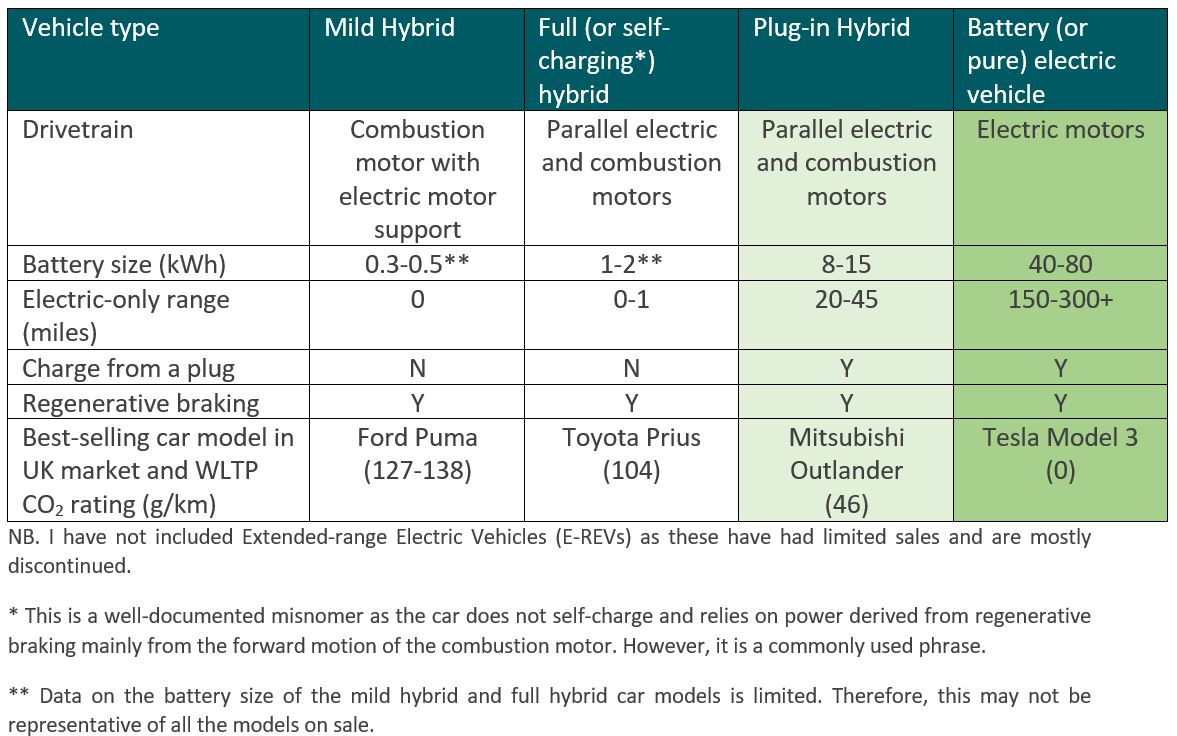 Olly Frankland, Regen’s EV and Innovation lead, provides a discussion on the role of mild hybrids cars in the UK market.
Olly Frankland, Regen’s EV and Innovation lead, provides a discussion on the role of mild hybrids cars in the UK market.
In this blog we cover the role of mild hybrids in the UK car market. There is considerable misunderstanding within the sector as to the definition of a mild hybrid. We start by clearing this up and comparing this technology with other options, then move on to discuss how successful they have been in gaining market share, and finally, to what extent mild hybrids are a form of greenwash.
All hybrid cars are powered by a combination of electric motors and internal combustion engines. However, in a mild hybrid, the main components of the technology are the following:
- The wheels cannot be directly powered by the electric motor(s) alone. The combustion motor is the only drivetrain. This is different from a full hybrid where the electric and combustion motors are parallel.
- The small electric motor and 48 V (12 V and 24 V are also available) battery, which is typically less than 0.5 kWh capacity, is only used to support the engine when accelerating, like a turbo charger. The system also helps start the engine and power the various parasitic electrical systems in the car, which means the engine spends more of its energy driving the wheels, increasing fuel efficiency.
An overview of the different electric vehicle types in comparison to a mild hybrid is provided in Table 1. The key differences to highlight for mild hybrids are the very small battery size, lack of any electric only range, and high WLTP CO2 rating in comparison with other vehicle types.
Table 1: Comparison of the key attributes of mild hybrids versus other electric vehicle types
Mild hybrid sales growth
The rise of the mild hybrid started in mid-2019 as more models came to market. Since then, they have increased from 0.8% of the UK car market to close to 20% in June 2021, surpassing other Electric Vehicle (EV) types in the market in a short space of time. A meteoric rise for a relatively new technology.
Link: https://public.flourish.studio/visualisation/6644162/
Why is there such a steep rise in mild hybrid sales?
Fiat, Ford, Jaguar Land Rover, Suzuki are a set of brands that are pushing mild hybrid options in their car models. I think it’s fair to say that these brands are not the leaders in the EV revolution, with limited number of plug-in car models available. So why use the mild hybrid technology? The answer unsurprisingly is the low cost. Delphi Autoparts (now part of Borgwaner), is one of the main providers of the mild hybrid technology and they state in their initial launch of the product that it will:
“provide 50 to 70 per cent of the benefit of a conventional high-voltage, full hybrid for just 30 per cent of the cost”[1].
This is the main driver for the use of the technology by car brands, an attempt to get some benefits of the hybrid technology for a very low cost, particularly in comparison with full hybrid, plug-in hybrid and battery-only options. This means they can undercut other cars that are more expensive in their class, while maintaining some green credentials in the eyes of the consumer.
We have seen car brands and their owner groups starting to get to grips with the scale of change necessary to be compliant with the new carbon emission limits set by the EU initially and replicated in the UK post Brexit[2]. A diversity in approaches to compliance has been on show over the past few years, as many brands try to maintain sales of conventional combustion engine car models through increased efficiency, form new alliances to share the burden, and many buying credits from other brands to avoid fines, in the drastic shift away from diesel cars and towards electrification. Mild hybrids would have been seen as the easiest and cheapest route a few years ago. However, the majority of larger brands are now looking at battery-only EV models as the main path to compliance over the next few years and up to the complete phase out of the sales of new fossil fuelled cars in 2030 in the UK. However, in the meantime, mild hybrid models are here to stay.
Is there greenwash in the marketing materials?
Regen has become interested in the issue of greenwash over the past few years, particularly in relation to green electricity tariffs – see here and here. We believe that greenwash is an ongoing problem in our move to net zero that deserves more attention. Mild hybrids are just the latest potential example.
Firstly, the mild hybrid debate is also closely related to the so-called “self-charging hybrid” discussion. Marketeers from Toyota and others have sold self-charging hybrids over those that need plugging in, as a key benefit to consumers. Norway’s consumer watchdog banned ads from Toyota using the phrase “self-charging hybrid” in early 2020[3], whereas the UK Advertising Standards Authority came to a different conclusion, allowing its use following an investigation in 2019.
If we take the marketing material from Ford for the Ford Puma as an example, it does state throughout the webpage that this is a mild hybrid model. However, when you look at the model name – Ford Puma 1.0 EcoBoost Hybrid 155 – the “mild” aspect of it has been dropped. It’s also very difficult to find details of the size of the battery for mild hybrid and full hybrid models (Table 1). Overall, as a consumer, it is very difficult to discern between a mild hybrid and other forms of hybrid technology. A clear definition and comparison would help consumers make a more informed choice.
Results from a quick survey question carried out on LinkedIn show that 78% of those that responded think that mild hybrids are a form of greenwash. The post has over thirteen thousand views and 150 votes. However, it must be said there was some confusion in the comments regarding the definition of a mild hybrid vs other EV types, which is further evidence of a problem in the market.
Summing up
Overall, the main problem is that the continued use of mild hybrids as a technology means that consumers think they are making a green choice when they purchase one. This is a form of greenwash, in the fairly new area of EVs, that is tough enough already for consumers to navigate. The result is that we now have 381,000 mild hybrid cars since mid-2019 on UK roads for, on average, the next 14 years[4], that could have been full-hybrids, plug-in hybrids or ideally battery-only EV cars – the latter choice in particular, helps to improve air quality through lower tailpipe emissions, lower carbon emissions, and save drivers money from lower running costs.
A ray of light lies with the Competitions and Markets Authority and the new consumer laws that are being drafted to help protect consumers from misleading environmental claims that specifically mentions car sales[5]. This new guidance and law will need to be implemented and enforced to make a meaningful difference to how brands communicate the benefits of their EVs to consumers. But it should help reduce the confusion and greenwash that currently distorts the EV market in the eyes of consumers. This backdrop has helped fuel the rise of the mild hybrid. The question is how many more will we see on our roads in the UK before 2030?
[1] https://www.delphiautoparts.com/gbr/en/node/187
[2]https://assets.publishing.service.gov.uk/government/uploads/system/uploads/attachment_data/file/1002092/green-paper-on-a-new-road-vehicle-CO2-emissions-regulatory-framework-for-the-United-Kingdom-web-version.pdf
[3] https://electrek.co/2020/01/24/toyota-self-charging-hybrid-ad-banned-norway-lie/
[4]https://www.smmt.co.uk/industry-topics/sustainability/average-vehicle-age/#:~:text=The%20average%20age%20of%20a,result%20of%20government’s%20scrappage%20scheme
[5] https://www.gov.uk/cma-cases/misleading-environmental-claims


